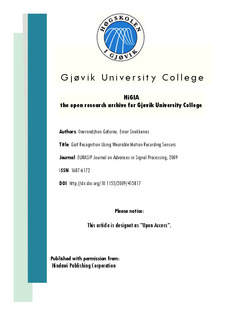Gait Recognition Using Wearable Motion Recording Sensors
Journal article, Peer reviewed

Åpne
Permanent lenke
http://hdl.handle.net/11250/142480Utgivelsesdato
2009Metadata
Vis full innførselSamlinger
Originalversjon
EURASIP Journal on Advances in Signal Processing, 2009 http://dx.doi.org/10.1155/2009/415817Sammendrag
This paper presents an alternative approach, where gait is collected by the sensors attached to the person's body. Such wearable sensors record motion (e.g. acceleration) of the body parts during walking. The recorded motion signals are then investigated for person recognition purposes. We analyzed acceleration signals from the foot, hip, pocket and arm. Applying various methods, the best EER obtained for foot-, pocket-, arm- and hip- based user authentication were 5%, 7%, 10% and 13%, respectively. Furthermore, we present the results of our analysis on security assessment of gait. Studying gait-based user authentication (in case of hip motion) under three attack scenarios, we revealed that a minimal effort mimicking does not help to improve the acceptance chances of impostors. However, impostors who know their closest person in the database or the genders of the users can be a threat to gait-based authentication. We also provide some new insights toward the uniqueness of gait in case of foot motion. In particular, we revealed the following: a sideway motion of the foot provides the most discrimination, compared to an up-down or forward-backward directions; and different segments of the gait cycle provide different level of discrimination.
Beskrivelse
Originally published in the EURASIP Journal on Advances in Signal Processing: http://www.hindawi.com/journals/asp/